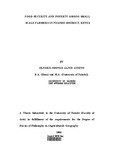| dc.description.abstract | This Study discusses Food Security and Poverty Issues with special reference
to Small-scale Farmers in Nyando District of Kenya. The District suffers from
problems of drought and frequent flooding, which negatively impact on agricultural
activities. Low food crop production and inadequate cash among various households,
make it incapable of benefiting from available food, which could be purchased from
neighbouring districts like Kisumu and Kericho. The objectives of the research
concentrated on establishing the influence of drought and floods on household food
security, examining the socio-economic factors that influence household food security,
examining how household population and health influence household food security,
and; investigating the significance of poverty as an important aspect of food security
among the small-scale farmers. The main research questions paused concern the
influence of unfavourable weather on household food security, socio-economic
constraints to household food security, the demographic and health factors influence
on household food security, and the role played by household poverty on household
food security. The formulated null hypotheses assumed no relationship between
household food security and the occurrence of droughts and floods, land availability,
household size and labour, family health and, distance to market, among other factors.
The hypotheses were tested using various statistical techniques to establish what
explains the rampant food insecurity and the prevalence of rural poverty in the study
area.
The sampling frame comprised of small-scale households within Nyando
District. The Locations sampled for this study were first stratified according to the
existing agro-ecological zones, which varied from high to medium and to low
agricultural potential areas. Using a sample size of 279 households, the first
household was chosen randomly, and systematic random sampling used to select other
households. The techniques of analysis included Multiple Correlation and Multiple
Regression Analysis, Stepwise Multiple Regression Analysis, Principal Component
Analysis, Factor Analysis and Cluster Analysis, which were selected on the basis of
the characteristics of data dealt with and the relevance of each technique. The analysis
regarding household food security and climatic factors established that, although
drought episodes frequently occur in the study area, they were not severe enough to
result into total crop failures as opposed to floods, where six months of flooding
resulted into total crop failure. During such periods of crop failures, various
households depended on food purchases using income from off-farm employment,
remittances from relatives, or Food- for-Work programmes, which were not always
available, with most of the households having inadequate funds for food purchases.
The findings of the analysis between household food security and socio-economic
factors revealed that land availability (farm size and land cultivated), household size
and labour, hired labour and, distance to the nearest market centre, all impact upon
household food security. These factors contributed nearly 50 percent of the variation
in household food security. The analysis concerning the demographic and health
factors and household food security revealed that morbidity and mortality were interdependent
and influence household food security both singularly and jointly. Further,
household size and family health related issues constituted nearly 50 percent of the
variations in household food production, and households having between 5 and 10
persons were found to be more productive than smaller household sizes.
The analyses using Principal Component Analysis, Cluster Analysis and Factor
Analysis, in comparison with the results from regression analyses, prioritize farm size,
family health and age of household head as principal components, determining the
improvement of household food security and reduction of household poverty. Other
conclusions emphasize the need to view household size as a resource rather than a
burden, maintaining farm sizes to economic units, and the use of suitable inputs and
appropriate technology. Further, in order to minimize the impact of droughts on
household food security, drought resistant crops should be encouraged, while also
prioritizing planning and management of floods. A minimum of farm size of 3
hectares is required per household in areas receiving unimodal rainfall patterns, with
those areas having two cropping seasons, which require at least 1.5 hectares. A new
definition of poverty is arrived at on the basis of food production and cash availability.
Major recommendations emphasize the need to provide farmers with timely climatic
data, incorporation of issues like age of household head and experience in farm work,
weather fluctuations and farm size in food policies. Dual-purpose crops (referring to
crops that qualify as both food and cash crops) are recommended together with
affordable farm inputs among other recommendations for policy makers | |

